Feature
Rethinking Online Science Learning
Creating Virtual Research Experiences Using Digitized Museum Specimens
Connected Science Learning March-April 2022 (Volume 4, Issue 2)
By Kirsten R. Butcher, Madlyn Larson, McKenna Lane, and Mitchell J. Power

A lasting impact of the COVID-19 global pandemic likely is the permanent inclusion of online learning in K–12. The rapid move to online learning left many teachers, parents, and students pining for in-person learning and highlighted major gaps in the online resources necessary for fully remote K–12 learning. But it also underscored considerable strengths of online formats for flexible learning and instruction—particularly as district capacities expanded and familiarity with online instruction increased. Many administrators now envision a permanent end to unplanned school closures (goodbye, snow days!) and long-term support for (at least intermittent) online learning. But what does continued online instruction mean for science learning, where hands-on learning is central to students’ developing skills and knowledge?
Science educators implementing online instruction have faced myriad challenges, including providing effective feedback and guidance while students engaged in more independent work. We greatly respect and admire the passion and dedication that science teachers have invested in finding creative ways to implement science inquiry during online pandemic instruction. As we move beyond “emergency” remote instruction and build on shared experiences with online science teaching, it is an ideal time to rethink science inquiry online and to collectively pursue new approaches to authentic science instruction with online resources.
Museums have been digitizing scientific collections for many years (e.g., the Field Museum, the Smithsonian), and multiple collecting institutions contribute digitized specimens to centralized databases (e.g., iDigBio, SCAN Bugs, Arctos, Intermountain Regional Herbarium Network). Although these databases are freely available and represent a significant resource for scientists, they lack user-friendly support for public exploration and provide insufficient scaffolding for classroom integration (Butcher et al. 2021). Our work seeks to bridge the existing chasm between digitized scientific collections and classroom learning. Digitized artifacts and specimens in museum collections are public resources with largely untapped potential to transform online science education.
Using digitized natural history collections from museums offers transformative opportunities to engage students in scientific exploration and analysis of real artifacts and specimens. For example, in one of our online investigations, students measure velvet ant specimens (see Figure 1)—very small female wasps with one of the most painful stings in the world! Digitized specimens offer a compelling—and sting-free—data collection experience. This example highlights the potential for natural history collections to reduce (or remove) multiple barriers that limit educational use of museum specimens, including
- museum loans to schools often are restricted to a small number of specimens that are damaged or otherwise unsuitable for inclusion in the museum’s permanent science collections;
- real specimens may be too valuable, fragile, or dangerous to allow hands-on manipulation by any public learners; and
- even when specimens can be handled by public learners, specimen characteristics may make it difficult for learners to collect accurate physical data (e.g., specimens may be very small).
Beyond removing barriers, online science investigations of digitized museum specimens offer numerous opportunities to enhance authentic science learning in classrooms.
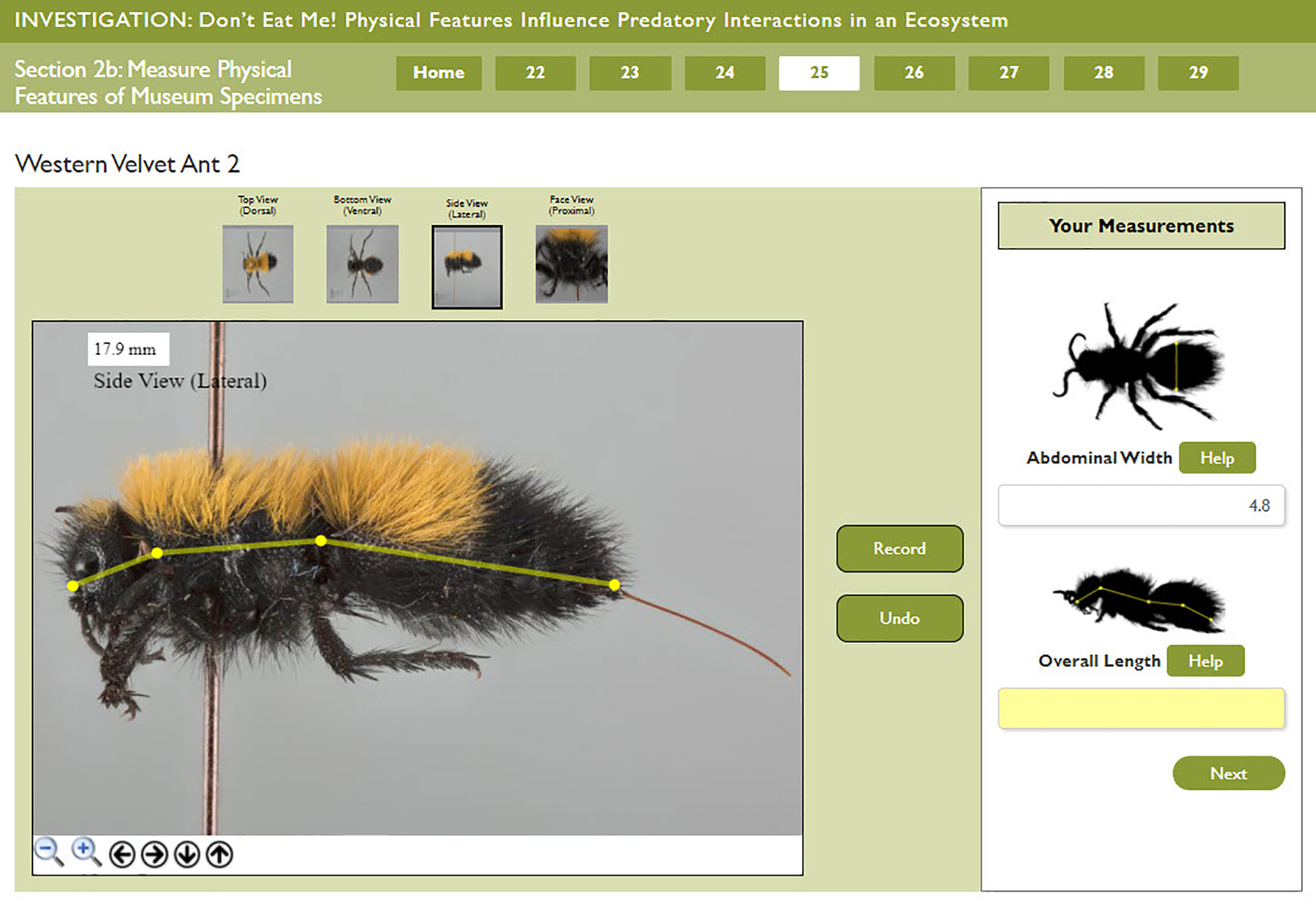
Why Use Digitized Museum Collections for Online Science Investigations?
- Natural history museum collections contain relevant data about pressing global issues (e.g., climate change), allowing students to learn science content, concepts, and practices by investigating contemporary science topics.
- Digitized museum collections reduce socioeconomic and geographic barriers to museum access, creating more equitable opportunities for students to engage in specimen research.
- Museum collections are engaging and interesting—students describe museum specimens in our investigations with vivid, emotional terms (e.g., cool, weird, freaky). Real-world materials help students connect scientific research to their own interests and experiences.
- Data collection from real, compelling museum artifacts and specimens—rather than artificial simulations or abstract data sets that are more commonly used—creates routine opportunities for engagement in interest-driven, sustained investigations.
- Working with data from digitized museum collections offers contextualized opportunities for students to practice arguing from evidence for effective sensemaking.
- Our museum-based investigations support students in understanding the enterprise of science as a whole—engaging with a question, gathering and analyzing relevant data, reasoning about findings, and communicating explanations.
Developing Collections-Based Science Investigations for Authentic, Online Learning
Over the last seven years, our interdisciplinary team of museum educators, domain experts/research scientists, and learning scientists from the Natural History Museum of Utah (NHMU) and the University of Utah has sought to transform science learning opportunities via the development of online investigations for middle school learners that leverage museum collections and align to the science practices of museum researchers. Resulting investigations are provided free online (ResearchQuest.org) to support three-dimensional science learning in keeping with the Next Generation Science Standards (NGSS) (Butcher, Larson, and Lane 2019; Butcher et al. 2021; Butcher, Runburg, and Hudson 2017). Two fundamental beliefs are at the heart of our approach:
- K–12 students need supported experiences in authentic research to develop knowledge, skills, and identities in science.
- All learners are entitled to access, explore, and conduct research on contemporary questions using the scientific collections available in national and global repositories.
Our design process is that the Natural History Museum of Utah (the collecting institution)—with its unique access to real specimens, science experts, and cutting-edge research—leads the development and publication of online investigation materials. But before designing investigation materials, we meet with teachers and scientists to determine existing synergies between NGSS standards and available scientific collections. We then move to collaborative design sessions with focus groups of teachers (typically 5–10 drawn from a pool of educator advisors) to review mockups and target activities. Based on teacher feedback, the design team next develops an online prototype that is evaluated independently by teachers (usually around 10) for approach, length, difficulty, and instructional supports. Following revisions, we engage current and future educators (around 20–25 individuals) to test a beta version of the investigation for refinement prior to full classroom testing. At each of these stages, teachers provide qualitative (e.g., free-form evaluative comments and reflection) and quantitative (e.g., ratings) feedback that helps our museum-based design team optimize investigations to be age-appropriate, aligned to standards, and flexible for customization based on teachers’ classroom needs and schedules.
Digitized Collections Transform Research Opportunities for Learners
Before the COVID-19 pandemic, the Natural History Museum of Utah was focused on creating digital investigations for collaborative pairs of students learning in-person (see Figure 2). However, the time is right to build on this work to create fully online, asynchronous research experiences using scientific collections; this shift is warranted by more than just the realities of the global pandemic. Today’s scientists routinely use online research with digitized collection specimens to conduct research and develop new insights about our world. For example, scientists have used museum collections to identify measurable changes over time as the Earth warms—including earlier plant flowering times (Davis et al. 2015) and changing appendage size in animals (Ryding et al. 2021). A decade ago, the world’s natural history collections contained an estimated 2–4 billion specimens (Ariño 2010)—digitized educational access to even a fraction of those specimens represents an astonishing public resource for science learning.
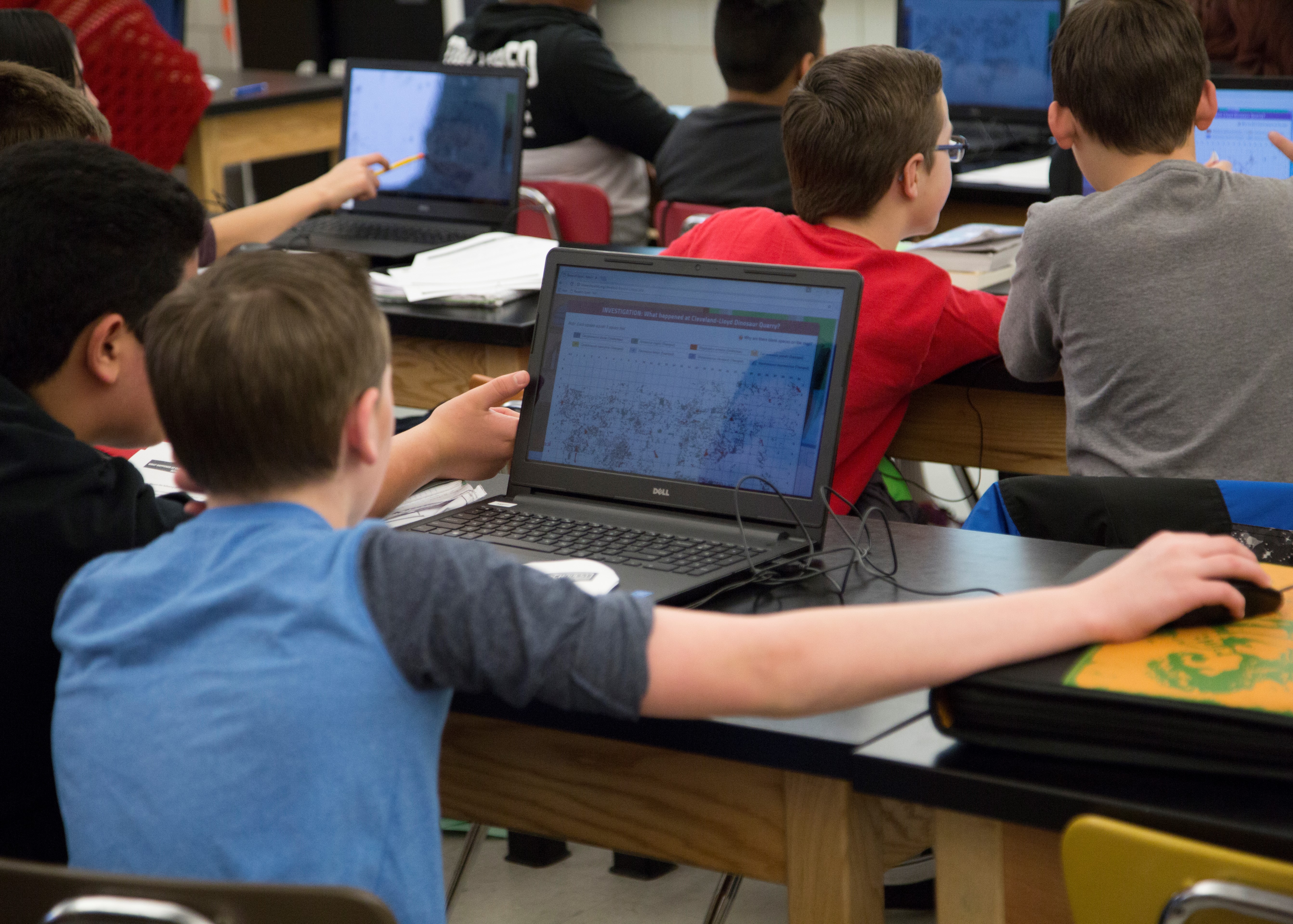
When embedded in well-supported, online experiences, digitized collections provide an engaging foundation for students to investigate contemporary science questions. With support from the National Science Foundation, our design team is developing a new set of online investigations—called EPIC Bioscience—that will be accessible on the Research Quest website. In EPIC investigations, learners collect and analyze data from digitized specimens in entomology, vertebrate zoology, and botany to address pressing global issues: climate change, biodiversity loss, resource scarcity, and human impacts on ecosystems. Learners collect data directly from digitized specimens using a variety of methods (e.g., observations, ratings, measurements, classification), then analyze their findings to construct evidence-based arguments about the complex, cascading effects of rapid changes in modern ecosystems. Current EPIC Bioscience investigations are being developed at the middle school level, aligned to four Next Generation Science Standards (NGSS MS-LS2-1 through MS-LS2-4).
Online Science Investigations Go Beyond Digitized Classroom Resources
Transitioning to all online delivery during the COVID-19 global pandemic provided illuminating insights on how to design asynchronous investigations in ways that enhance learner motivation, attention, and engagement. Prior to the pandemic, our team had years of experience in designing, testing, and refining Research Quest investigations as digitized resources for collaborative student use in face-to-face classrooms (using laptops, Chromebooks, or iPads). Our initial design and development of EPIC Bioscience investigations were based on these successful, previous digital resources—materials were online and ready for guided classroom instruction. But as classrooms transitioned to remote learning and needed increased opportunities for independent, virtual learning experiences, we set out to explore the potential for EPIC investigations to facilitate meaningful asynchronous online science investigations.
We conducted a series of evaluations with practicing and preservice teachers to examine the content, flow, and instructional supports offered by EPIC investigations. Ten practicing science teachers individually stepped through the online investigations and provided quantitative ratings and detailed qualitative feedback. In addition, 21 preservice teachers completed the investigations from a learner perspective, then provided (qualitative and quantitative) survey feedback on investigation quality and support. We intentionally evaluated materials with multiple teaching populations to ensure their value and ease of implementation for broad populations of educators.
Analyses drew upon several data sources. First, we examined quantitative, Likert-style ratings data (e.g., Strongly Agree – Strongly Disagree) for statements related to design features (e.g., Guidance: Students will know what to do at each step). Second, qualitative feedback (e.g., What did you like best about this activity? What did you like least about this activity? What advice do you have for successful implementation of the investigation in classrooms?) was analyzed via thematic coding (see Table 1). Finally, videos of preservice teacher learning sessions (where they completed investigation activities while thinking aloud) were analyzed to determine the presence or absence of major themes. Themes were identified in think-aloud statements as well as in observed, on-screen actions. Resulting themes (both positive and negative) were compared to previous observations and findings collected during in-person, classroom use of Research Quest investigations. This provided us with key insights about when asynchronous, online learning may require different features than those that were effective for synchronous, online learning.
Results from EPIC evaluations indicated the need to consider unique design features for online, asynchronous investigations. Even experienced educators (who are used to providing high-quality guidance and support in classroom environments) did not anticipate the extent to which asynchronous investigations would require additional considerations beyond synchronously supported digital materials. As seen in Table 1, only around 20% of practicing teachers (and even fewer preservice teachers) anticipated that learners would reject peer data, fail to engage with feedback, or process instructional content superficially; in contrast, these issues were observed frequently in the videos of asynchronous learning sessions (53–86% of learner experiences demonstrated these issues).
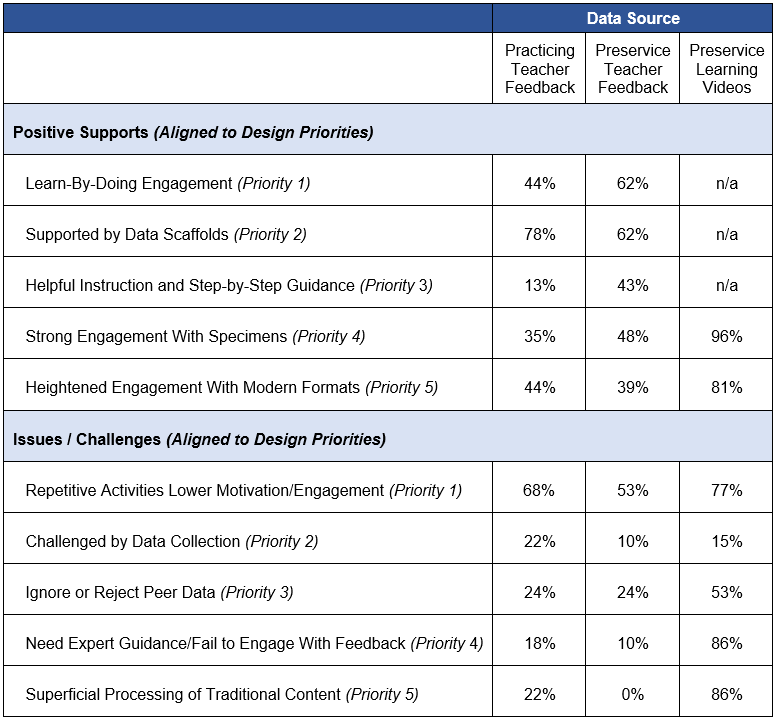
Drawing from these findings, we extracted five design priorities to guide revisions as well as to inform the design, evaluation, and selection of other online science investigations. During our revision process, we discovered that implementing these design priorities for asynchronous learning resulted in creative and efficient materials that translate to synchronous, face-to-face contexts with fidelity and offer future instructional flexibility.
Priority 1: Dive Into Student-Driven Exploration for Motivation and Hands-On Learning
Prior to engaging students in hands-on lessons, classroom teachers often seek to activate students’ prior knowledge and motivation—for example, by identifying observed phenomena, discussing compelling questions, or demonstrating connections to real-world contexts. Comparing in-person learning sessions with Research Quest investigations (see Figure 2) with the asynchronous learning sessions with EPIC Bioscience investigations, we have observed that social dynamics in the classroom—including interpersonal relationships among teachers and students—draw the learner into classroom preparation activities in ways that are difficult (if not impossible) to replicate in asynchronous, online investigations. In asynchronous learning sessions, we have observed that—even if they read or watch online introductory materials—learners often fail to encode the information in such a way that they apply it to subsequent activities. We infer that, lacking the social context of the classroom, prior knowledge activation and motivation in online, asynchronous investigations must be targeted by immediate, highly experiential opportunities; that is, creating questions, motivation, and awareness via learning-by-doing. Essentially, this flips the order of more traditional classroom instruction—through guided, student-driven exploration, students prepare themselves to engage with key concepts by generating questions, activating ideas, or wondering about outcomes.
We have implemented this design priority in our EPIC Bioscience investigations by creating customized introductory activities that require little prior knowledge or facilitated instruction and get students immediately engaged with digitized specimens (see Figure 3). Students dive right in—interactions are experiential but supported via immediate feedback that is automatically provided by the online system (not by teacher intervention). Students become motivated to complete investigations through questions and ideas that arise during these introductory, exploratory experiences. In the case of EPIC Bioscience investigations, these learn-by-doing experiences are carefully designed to align to investigation questions and target standards. When using learn-by-doing materials that are not strategically aligned to standards or investigations, teachers need to create clear goals and prompts that help focus learners on key concepts, principles, questions, hard-to-see phenomena, or counterintuitive outcomes without delaying their entry into the exploratory experience.
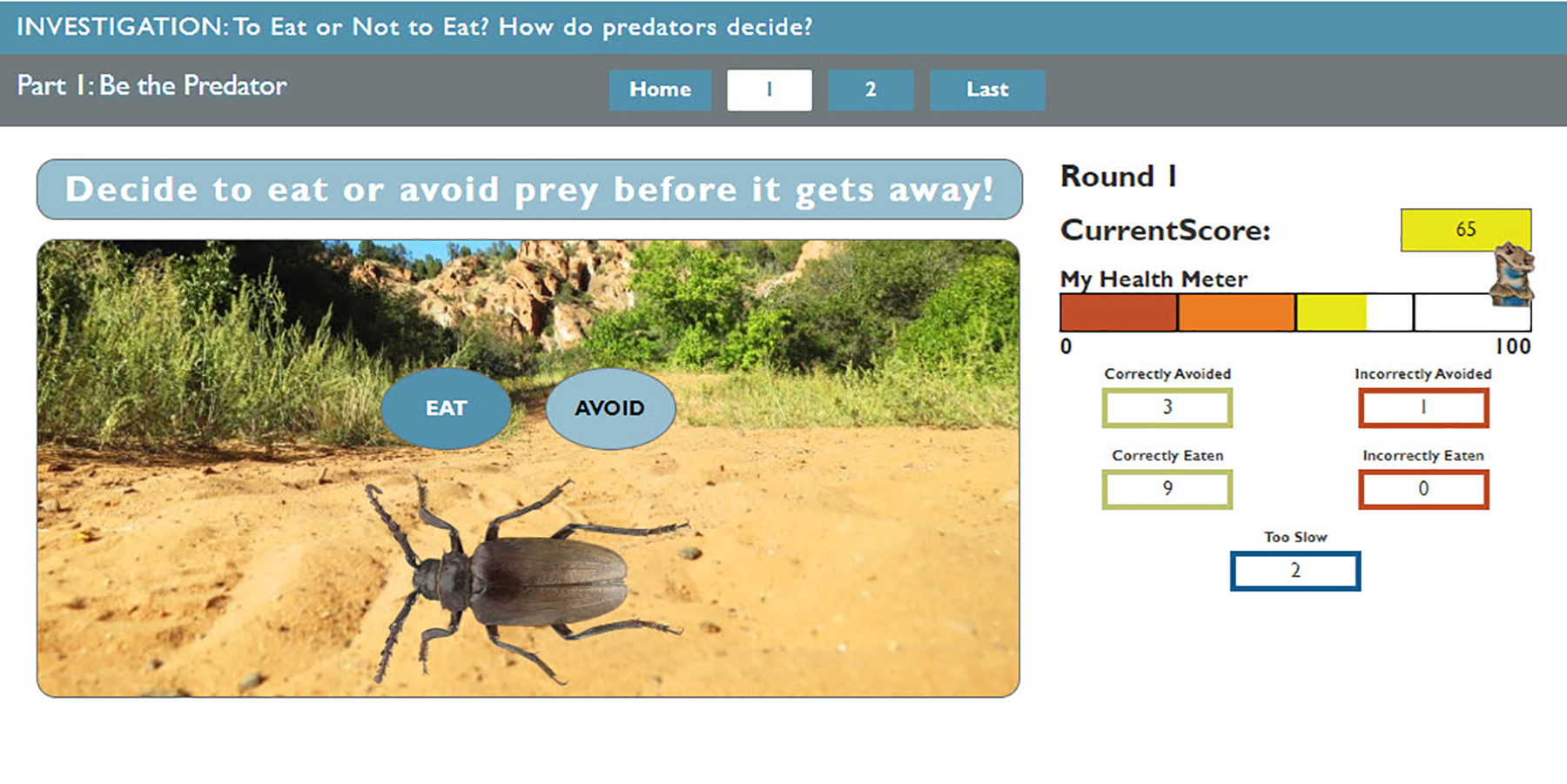
Interactivity is essential during introductory activities and critical to redefining “hands-on” learning in modern educational contexts. Educators may not find the hands-on opportunities provided by digitized specimens (particularly static images) to be immediately obvious. However, we have found that a series of high-quality images can be decidedly interactive as students zoom in and out, switch views, and measure or organize these images in a variety of ways. In fact, embedding images into online science investigations can enable a more in-depth exploration than is possible with the physical specimens themselves. Particularly for small/fragile physical specimens, online images and interactive tools allow learners to observe specimens in greater detail and to virtually manipulate them in more dynamic ways (see Figure 4). Teachers can leverage new forms of hands-on science by seeking online investigations that allow student-directed exploration with real (but virtual) specimens.
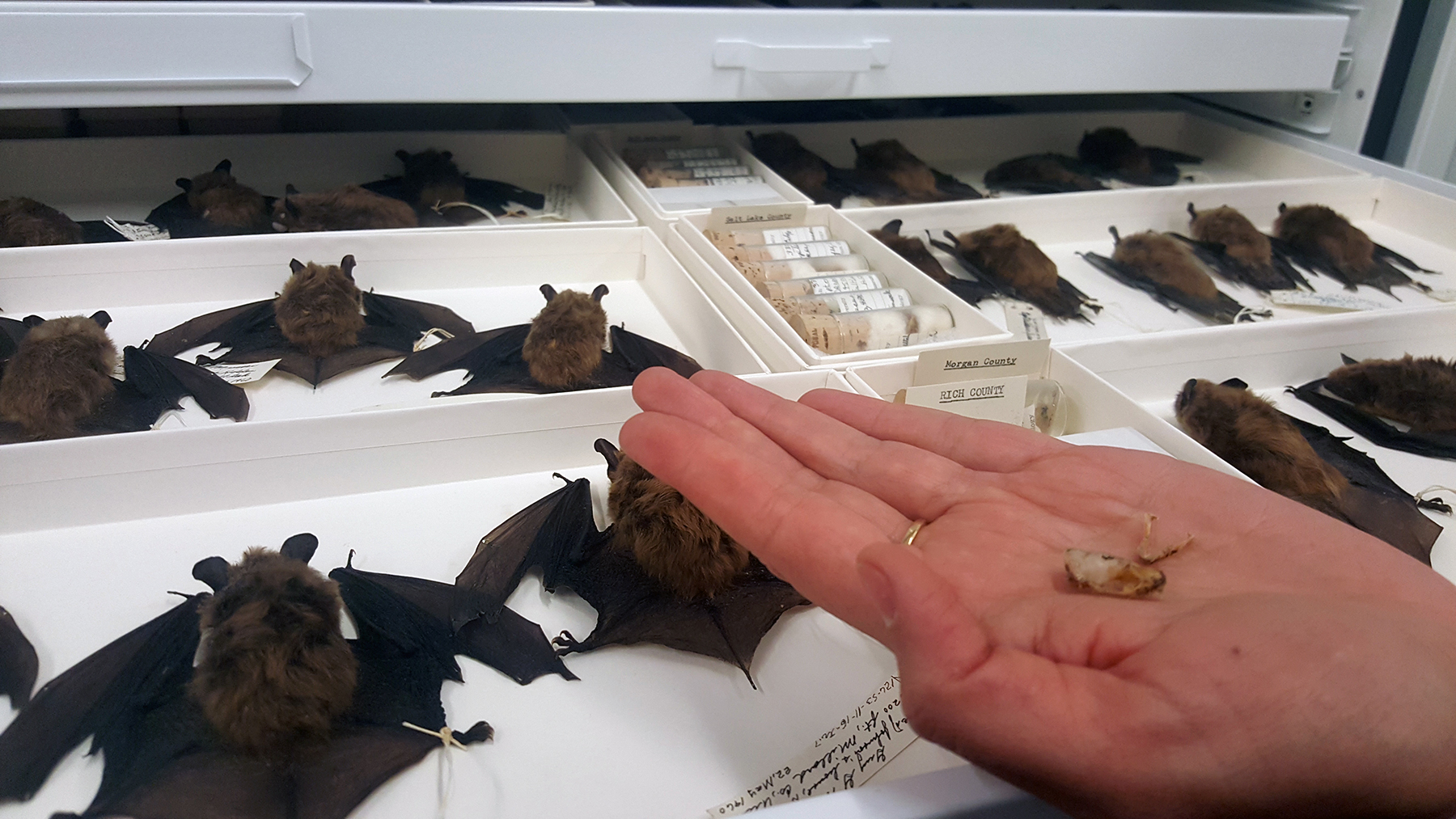
Priority 2: Use Online Scaffolds to Offload Complex Demands
Fully supported, online science investigations not only provide students with frequent access to high-value scientific specimens (i.e., specimens of sufficient quality and importance to be included in a museum collection) but also provide opportunities to offload some methodological and organizational aspects of science investigations in ways that allow students to focus more strongly on data analysis and interpretation. When collecting data in traditional science investigations, significant amounts of student (and teacher) time can be spent recording and organizing data to facilitate analysis. Data documentation and organization are, without a doubt, essential skills for students to learn. But students who struggle with basic documentation may not complete an investigation or may wind up with unusable data at the end of their efforts. In the case of digitized specimens, online scaffolds help ensure sufficient progress and successful documentation, so that all students have the opportunity to reason with data that they collected. EPIC Bioscience investigations model data documentation and organization (see Figure 5) and provide students and teachers with multiple options for access (e.g., downloading data tables and summaries).
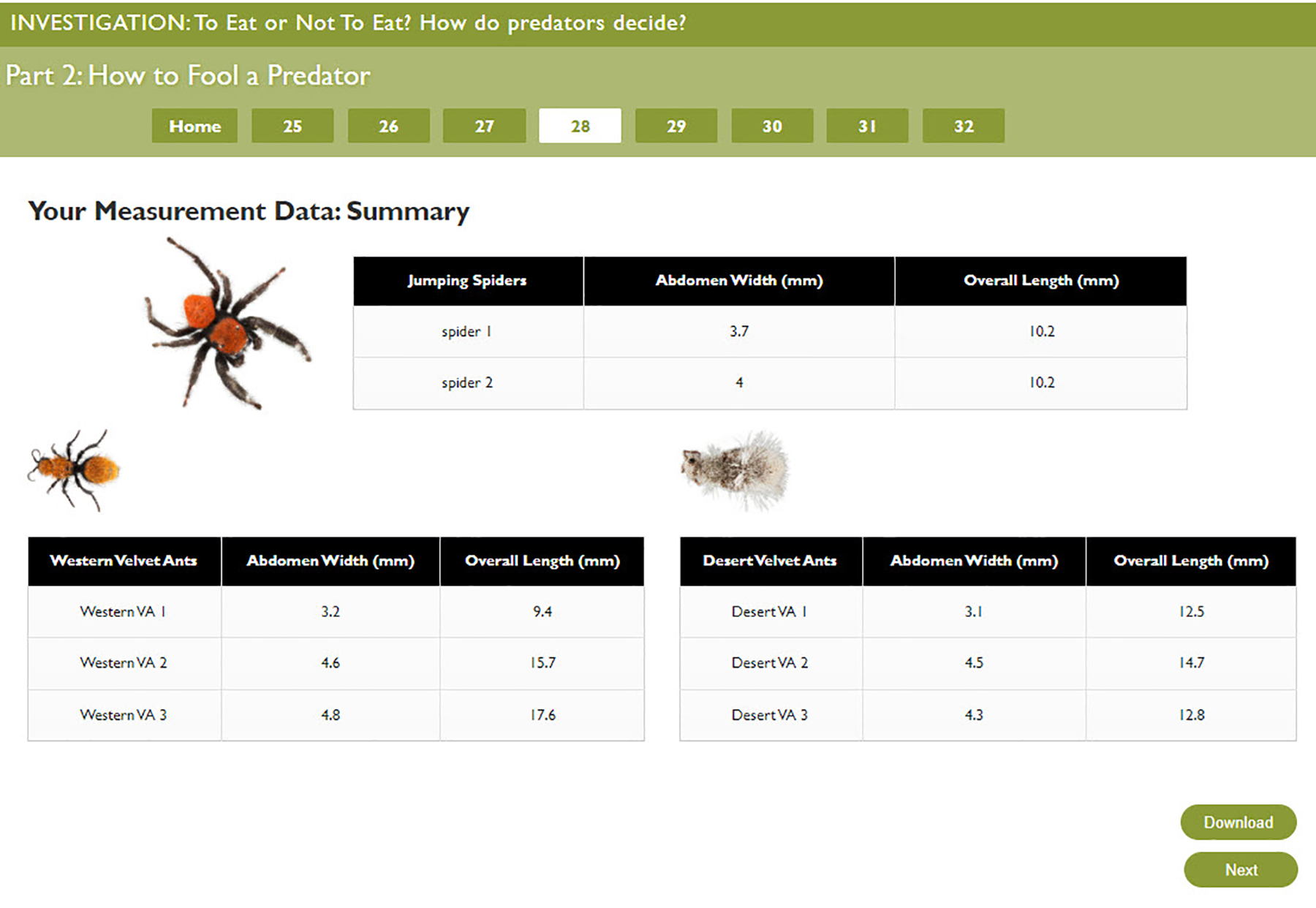
To facilitate development of data understanding, we recommend that teachers seek online investigations in which data documentation and organization is supported and modeled, but not hidden. Students should not move from data collection to a “magic” presentation of results—they need to see how data is recorded and formatted for analysis! We also recommend teachers prioritize resources that allow students to view, access, and (ideally) download their own data. Data downloads can serve as the basis of extension activities, where students further explore a data set for which they understand its context and meaning—because they collected it!
Priority 3: Digital Mentors Are Critical Sources of Feedback and Guidance
One of our more surprising design findings was that peer-comparison and feedback—methods that worked well in classrooms to support error revision and reflection—were not effective approaches to enhancing reflective thinking during remote science investigations. Students completing asynchronous, online investigations routinely assumed that peer data was incorrect or their own data was “close enough.” As a result, asynchronous learners were unlikely to reflect on discrepant data or conclusions—even if they previously had expressed confusion or uncertainty about their own processes or ideas.
This finding provides a daunting challenge when developing online science investigations, as real-time advice and feedback by live mentors (e.g., scientists or teachers) is not a scalable option. Thus, we must be creative in finding ways to help students attend to feedback and guidance during self-directed, remote work. Our approach with EPIC Bioscience has been to create customized, virtual support that is aligned to students’ actions and progress in the investigation but does not require live human monitoring. We recruit practicing scientists in the domain of an investigation (e.g., entomology) to serve as virtual mentors. Scientists pose for a series of photographs that vary their facial expressions and gestures, allowing us to create customized virtual screens that reflect positive and negative feedback, questions, and other conversational turns (see Figure 6). Guidance and feedback is not live, but it is immediate and customized to a student’s individual actions in the system. Digital mentors facilitate social connection as well as providing ever-present support.
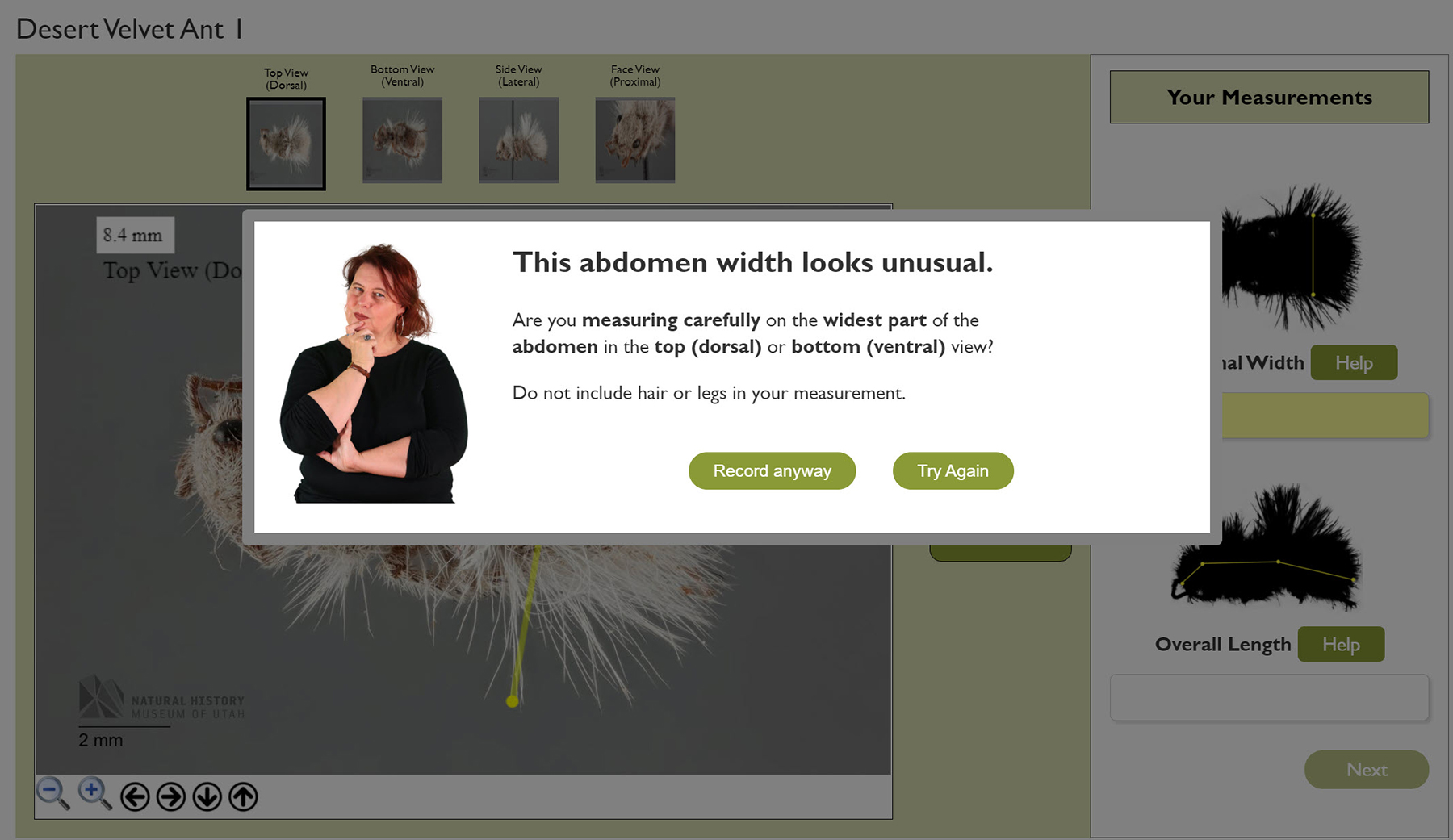
Beyond our Research Quest and EPIC Bioscience investigations, not all systems offer digital mentorship. In these cases, teachers are advised to look for online materials that provide immediate feedback on student actions and incorporate some form of social characters (e.g., avatars) to connect with learners. We recommend that teachers avoid “all positive” systems where praise is provided for any response—students should receive positive feedback for correct/accurate responses and constructive feedback to improve incorrect/inaccurate responses.
Priority 4: Use Visual Feedback and Cues for High-Impact Instruction
In instructional contexts, we want students to understand what they are doing, why they are doing it, and why it matters. In classrooms, these goals often form the basis of instructional explanations that support meaningful classroom discourse. However, in online contexts, even brief instructional explanations can result in text-heavy experiences that disengage students. Students frequently skip even small amounts of text online, making alternative presentations of instructional content critical for effective learning. To solve this problem, we have challenged ourselves to develop visual approaches to instruction, hints, and help (see Figure 7). As we prioritized visual design, we found that we often were able to replace paragraphs of text explanation with clear, focused visuals accompanied by very brief supporting text.
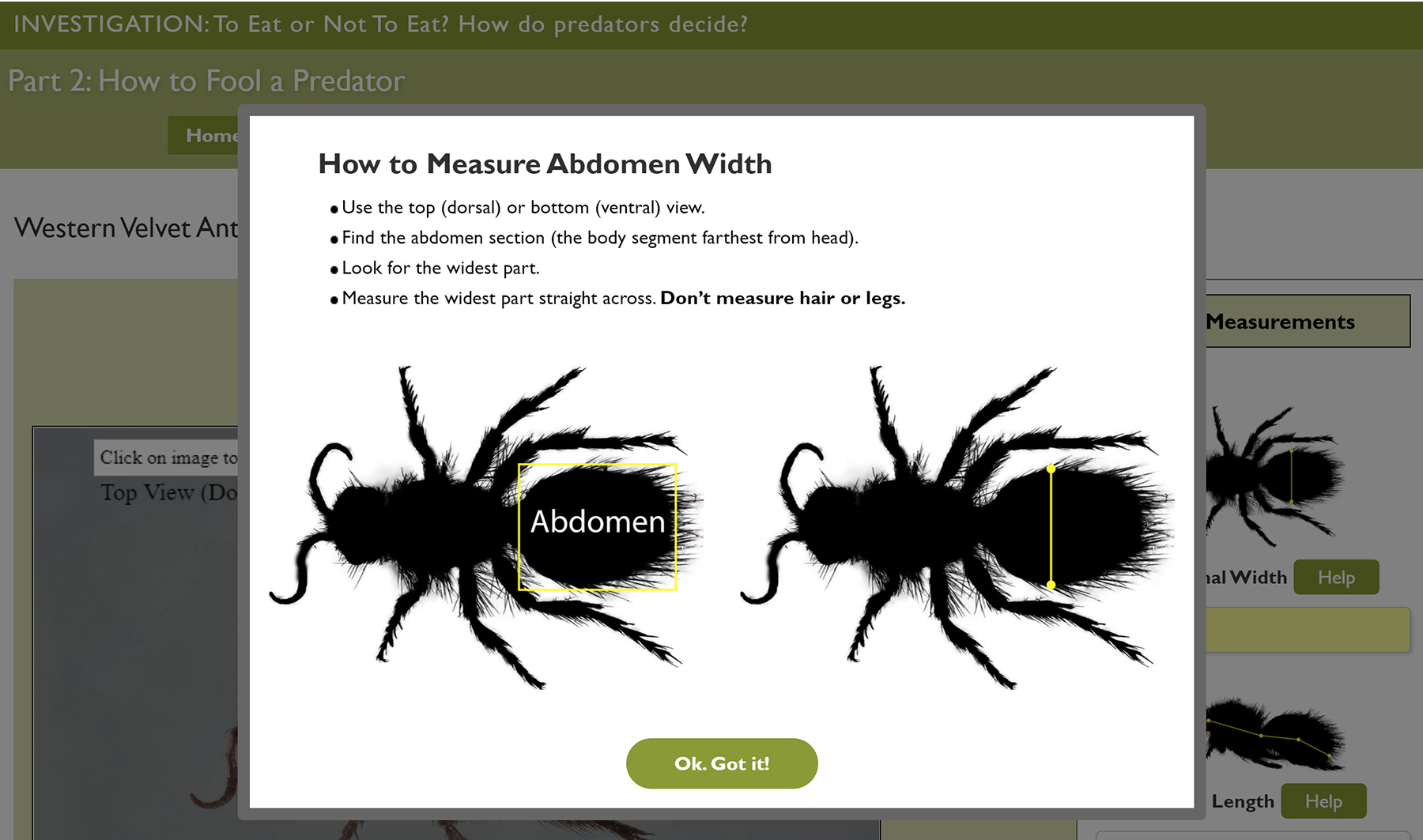
In selecting online investigations, we recommend that teachers prioritize visual instruction, as well as visual cues in help or scaffolding. Teachers also can look for resources that use visual cues to help students get started quickly on activities. We recognize that learners with visual impairments may not benefit equally from these materials, and an emphasis on visual feedback and cues is not an excuse to ignore best practices for accessibility (e.g., high-quality alt text). However, carefully designed visual content has been a woefully underused technique to support, engage, and guide learners online.
Priority 5: Enhance Interest via Modern Instructional Formats
Today’s students are 21st-century learners who have been immersed in technology and media exposure since birth. Online formats afford us the opportunity to be creative and playful with our instructional materials in ways that draw upon and connect to what students see and experience in their everyday lives. We have been challenging ourselves to think about the materials that students see outside of school and to creatively repurpose those materials for instruction (see Figure 8). For example, in one investigation, we use educational comics to introduce key concepts (e.g., What is mimicry?) and background information (e.g., What is a velvet ant?). In another activity, students select an emoji to react to—and thereby self-pace—text message guidance from their (digital) scientist mentor. We continue to challenge ourselves to present instructional content in innovative and unexpected formats to engage learners and encourage teachers to look for instructional materials that mimic the rich media and technology-based communication in which 21st-century learners are immersed.
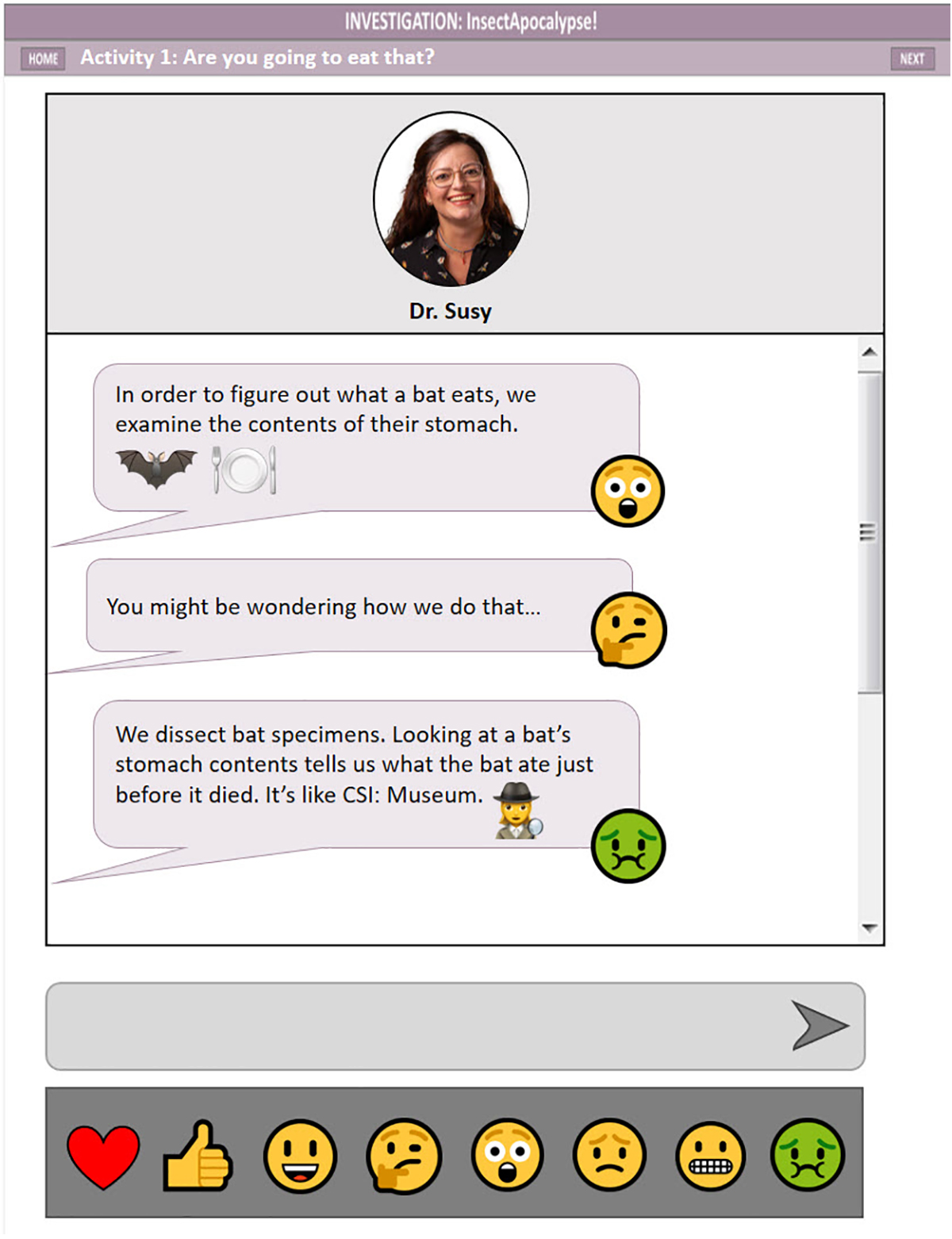
Limitations and Remaining Challenges
Our work has uncovered several existing limitations and remaining challenges in using student-centered, authentic science investigations for asynchronous online formats. One current limitation is the relatively small number of collections-based research investigations that are available to teachers. Sustained integration of online, collections-based research into classroom learning will require that we continue to expand the number and range of available investigations. Another limitation is that—despite many improvements in online access made during the global pandemic—inequities in connectivity remain. Access to high-speed internet and high-quality devices must continue to be improved to achieve fully equitable online science learning.
Another limitation and challenge is that authentic science research in classrooms requires time and patience for sufficient data collection. Realistic research necessitates collecting data from multiple samples to ensure representative data for analysis. Although our current investigations streamline data collection by allowing students to combine their own data with larger samples, teachers will need to cultivate student stamina for sustained data collection.
A related limitation and key challenge—one with which we continue to grapple—is the increased demands that authentic science investigations place on students’ data literacy skills. Students can become distracted by unimportant patterns in graphs or small differences in measured data that are not relevant to larger questions. Students likely will need early (and repeated) exposure to concepts of variability, error, and outliers.
Finally, a critical challenge in online science investigations with real specimens is helping students become comfortable with uncertainty and disagreement. This can be especially difficult in asynchronous environments. Classrooms are social, interactive settings where peers play a valuable role in proposing alternative ideas, hypotheses, or interpretations. Strategic documentation can help students develop multiple ideas and examine evidentiary support more carefully (Butcher et al. 2019), but it is particularly useful when combined with classroom discourse. Teachers likely will need to implement online tools for discussion (and to seed student communication using targeted questions and prompts) to expose students to a range of thinking, findings, and outcomes—particularly to explore how and why findings may differ.
Join the Research Quest Community
We hope that you are enthusiastic about the incredible potential of museum specimens to engage your students in compelling, authentic online science investigations. Create a free account at ResearchQuest.org to access all investigation materials and teacher resources—you also can contact our team via your account. We welcome your ideas, feedback, and suggestions as we move forward, together, toward a new era in online science learning.
We also are seeking partners from museums or collecting institutions interested in developing their own collections-based investigations. We would be delighted to share our experiences and helpful materials (i.e., guidance for collections selection), as well as to strategically combine collections to address temporal or spatial gaps. We invite you to get in touch and join us in our mission to transform science learning by making classrooms a place where students can engage in authentic research with digitized collections.
Acknowledgments
The authors wish to thank the large, dedicated group of scientists, researchers, educators, and graduate students who have contributed to the development of Research Quest and EPIC Bioscience investigations. EPIC Bioscience investigations are based upon work funded by the National Science Foundation under Grant #1812844. Any opinions, findings, and conclusions or recommendations expressed in this material are those of the authors and do not necessarily reflect the views of the National Science Foundation.
Kirsten R. Butcher (kirsten.butcher@utah.edu) is an Associate Professor of Instructional Design and Educational Technology at the University of Utah in Salt Lake City, Madlyn Larson is Associate Director of Education Initiatives at the Natural History Museum of Utah in Salt Lake City, McKenna Lane is a Digital Learning and Curriculum Specialist at the Natural History Museum of Utah and a PhD student at the University of Illinois Urbana–Champaign in Urbana, and Mitchell J. Power is a Professor of Geography at the University of Utah and Curator of the Garrett Herbarium at the Natural History Museum of Utah in Salt Lake City.
citation: Butcher, K.R., M. Larson, M. Lane, and M.J. Power. 2022. Rethinking online science learning: Creating virtual research experiences using digitized museum specimens. Connected Science Learning 4 (2). https://www.nsta.org/connected-science-learning/connected-science-learning-march-april-2022/rethinking-online-science
Instructional Materials NGSS Research STEM Technology Middle School Informal Education


